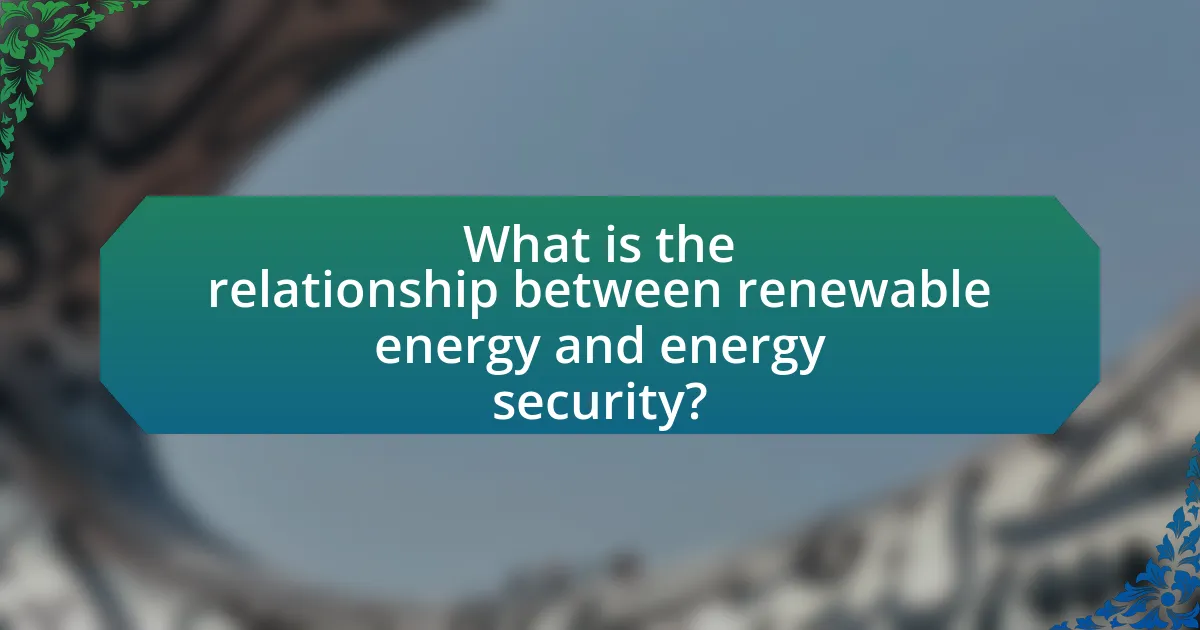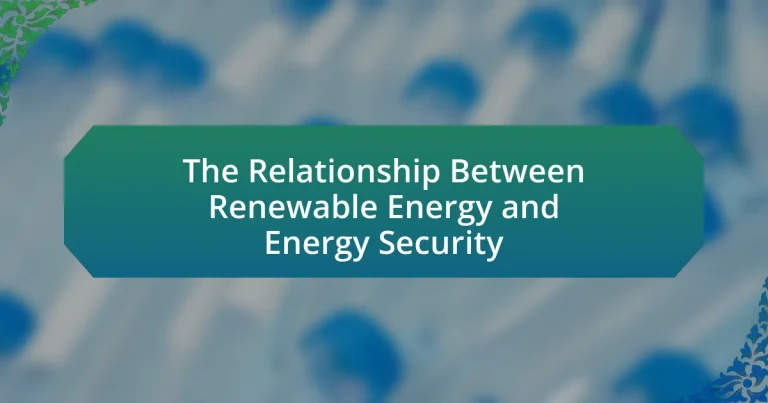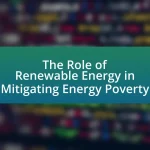The article examines the relationship between renewable energy and energy security, highlighting how renewable sources such as solar, wind, and biomass contribute to energy independence and resilience. It discusses the benefits of diversifying energy sources to mitigate risks associated with geopolitical tensions, supply disruptions, and price volatility in fossil fuel markets. Additionally, the article addresses the challenges of integrating renewable energy into existing frameworks, including technological barriers, regulatory issues, and the need for infrastructure improvements. It emphasizes the importance of government policies in promoting renewable energy adoption and outlines best practices for enhancing energy security through sustainable energy solutions.

What is the relationship between renewable energy and energy security?
Renewable energy enhances energy security by diversifying energy sources and reducing dependence on fossil fuels. This diversification mitigates risks associated with supply disruptions, geopolitical tensions, and price volatility in global energy markets. For instance, countries that invest in renewable energy technologies, such as wind and solar, can generate electricity domestically, leading to greater energy independence. According to the International Renewable Energy Agency (IRENA), increasing the share of renewables in the energy mix can significantly lower energy import bills and improve resilience against external shocks.
How do renewable energy sources contribute to energy security?
Renewable energy sources enhance energy security by diversifying the energy supply and reducing dependence on fossil fuels. This diversification mitigates risks associated with supply disruptions caused by geopolitical tensions or natural disasters. For instance, countries that invest in solar, wind, and hydroelectric power can generate energy locally, decreasing vulnerability to external energy market fluctuations. According to the International Renewable Energy Agency (IRENA), increasing the share of renewables in the energy mix can lead to a more resilient energy system, as evidenced by the fact that renewable energy capacity has grown by over 200% globally from 2000 to 2020, providing a more stable and sustainable energy future.
What types of renewable energy sources are most relevant to energy security?
The types of renewable energy sources most relevant to energy security include solar energy, wind energy, and biomass energy. Solar energy provides a decentralized power generation option, reducing reliance on imported fuels and enhancing resilience against supply disruptions. Wind energy contributes significantly to energy independence, as countries can harness local wind resources, thereby decreasing vulnerability to geopolitical tensions. Biomass energy, derived from organic materials, offers a sustainable alternative that can be produced locally, further bolstering energy security by diversifying energy sources and reducing dependence on fossil fuels. These renewable sources collectively enhance energy security by promoting sustainability, reducing emissions, and ensuring a stable energy supply.
How does the diversification of energy sources enhance energy security?
Diversification of energy sources enhances energy security by reducing dependence on a single energy supply, thereby mitigating risks associated with supply disruptions. When a country utilizes multiple energy sources, such as solar, wind, natural gas, and nuclear, it can better withstand geopolitical tensions, natural disasters, or market fluctuations that may affect one particular source. For instance, the International Energy Agency (IEA) reports that countries with a diverse energy mix are less vulnerable to price volatility and supply interruptions, as they can shift to alternative sources when one is compromised. This strategic approach not only stabilizes energy prices but also promotes resilience in the energy system, ensuring a more reliable and secure energy supply for consumers and industries.
Why is energy security important in the context of renewable energy?
Energy security is crucial in the context of renewable energy because it ensures a stable and reliable supply of energy while reducing dependence on fossil fuels. Renewable energy sources, such as solar and wind, are abundant and can be harnessed locally, which mitigates risks associated with geopolitical tensions and market volatility that often affect fossil fuel supplies. For instance, the International Renewable Energy Agency (IRENA) reported that increasing the share of renewables in the energy mix can enhance energy independence and resilience, thereby contributing to national security. This transition not only supports environmental sustainability but also stabilizes energy prices and promotes economic growth by creating jobs in the renewable sector.
What are the risks associated with reliance on non-renewable energy sources?
Reliance on non-renewable energy sources poses significant risks, including environmental degradation, resource depletion, and geopolitical tensions. The extraction and burning of fossil fuels contribute to air and water pollution, leading to health issues and ecosystem damage. For instance, the International Energy Agency reported that fossil fuel combustion is responsible for approximately 70% of global greenhouse gas emissions, exacerbating climate change. Additionally, non-renewable resources are finite; the U.S. Geological Survey estimates that at current consumption rates, oil reserves could be depleted within 50 years. This scarcity can lead to increased competition for resources, heightening geopolitical conflicts, particularly in regions rich in fossil fuels. Thus, the reliance on non-renewable energy sources presents critical risks that impact environmental health, resource availability, and global stability.
How can renewable energy mitigate geopolitical risks related to energy supply?
Renewable energy can mitigate geopolitical risks related to energy supply by reducing dependence on fossil fuels, which are often concentrated in politically unstable regions. By diversifying energy sources through wind, solar, and hydroelectric power, countries can enhance their energy security and decrease vulnerability to supply disruptions caused by geopolitical tensions. For instance, the International Renewable Energy Agency (IRENA) reported that increasing the share of renewables in the global energy mix can lead to greater energy independence and stability, as countries can harness local resources rather than relying on imports from volatile regions. This shift not only fosters energy resilience but also promotes economic stability by insulating nations from price fluctuations and supply chain disruptions associated with traditional energy markets.
What challenges exist in integrating renewable energy into energy security frameworks?
Integrating renewable energy into energy security frameworks faces several challenges, primarily related to intermittency, infrastructure, and policy alignment. Intermittency refers to the variable nature of renewable energy sources like solar and wind, which can lead to supply fluctuations that complicate grid stability and reliability. For instance, the International Energy Agency (IEA) reports that integrating a high share of renewables requires enhanced grid management and storage solutions to mitigate these fluctuations.
Infrastructure challenges arise from the need for significant investments in transmission and distribution systems to accommodate decentralized energy generation. According to the U.S. Department of Energy, outdated grid infrastructure can hinder the effective integration of renewable sources, necessitating modernization efforts that can be costly and time-consuming.
Policy alignment is another critical challenge, as existing energy security frameworks often prioritize fossil fuels and may lack incentives for renewable energy adoption. The World Bank highlights that inconsistent regulatory frameworks can create barriers to investment in renewable technologies, further complicating their integration into energy security strategies.
What technological barriers hinder the adoption of renewable energy?
Technological barriers that hinder the adoption of renewable energy include high initial costs, insufficient energy storage solutions, and limited grid infrastructure. High initial costs for renewable energy technologies, such as solar panels and wind turbines, can deter investment; for instance, the International Renewable Energy Agency reported that upfront costs can be a significant barrier, despite long-term savings. Insufficient energy storage solutions, such as batteries, limit the ability to store energy generated during peak production times for later use, which is crucial for managing supply and demand. Additionally, limited grid infrastructure can impede the integration of renewable energy sources into existing energy systems, as many grids were designed for centralized fossil fuel generation rather than decentralized renewable sources.
How do regulatory and policy challenges affect renewable energy deployment?
Regulatory and policy challenges significantly hinder renewable energy deployment by creating barriers to investment and implementation. These challenges include inconsistent regulations, lengthy permitting processes, and lack of supportive policies, which can deter private sector investment. For instance, a report by the International Renewable Energy Agency (IRENA) highlights that regulatory uncertainty can lead to a 20-30% increase in project costs, ultimately slowing down the transition to renewable energy sources. Furthermore, policies that favor fossil fuels over renewables can distort market dynamics, making it difficult for renewable energy projects to compete effectively.
How can renewable energy enhance national energy security?
Renewable energy enhances national energy security by diversifying energy sources and reducing dependence on imported fuels. This diversification mitigates risks associated with geopolitical tensions and supply disruptions, as countries can rely on domestically produced energy from sources like solar, wind, and hydro. For instance, according to the International Renewable Energy Agency (IRENA), countries that invest in renewable energy can decrease their vulnerability to price volatility in fossil fuel markets, thereby stabilizing their energy supply. Additionally, renewable energy systems are often decentralized, which increases resilience against natural disasters and cyber threats, further strengthening national energy security.
What role do government policies play in promoting renewable energy for energy security?
Government policies are crucial in promoting renewable energy for energy security by providing regulatory frameworks, financial incentives, and research support. These policies encourage investment in renewable technologies, which reduces dependence on fossil fuels and enhances energy resilience. For instance, countries like Germany have implemented feed-in tariffs that guarantee fixed payments for renewable energy producers, leading to a significant increase in solar and wind energy capacity. According to the International Renewable Energy Agency, renewable energy sources accounted for over 80% of new power generation capacity globally in 2020, driven largely by supportive government policies.
What are the specific benefits of renewable energy for energy security?
Renewable energy enhances energy security by diversifying energy sources and reducing dependence on fossil fuels. This diversification mitigates risks associated with supply disruptions, geopolitical tensions, and price volatility in global energy markets. For instance, countries that invest in solar, wind, and hydroelectric power can generate electricity domestically, decreasing vulnerability to foreign energy supply shocks. According to the International Renewable Energy Agency (IRENA), renewable energy can provide up to 80% of the world’s energy needs by 2050, significantly bolstering energy independence and stability. Additionally, renewable energy systems are often decentralized, which increases resilience against natural disasters and cyber threats, further contributing to overall energy security.
How does renewable energy contribute to economic stability?
Renewable energy contributes to economic stability by reducing dependence on imported fuels, which mitigates vulnerability to price volatility and supply disruptions. For instance, countries that invest in solar, wind, and hydroelectric power can generate their own energy, leading to more predictable energy costs and fostering local job creation in the renewable sector. According to the International Renewable Energy Agency (IRENA), the renewable energy sector employed over 11 million people globally in 2018, demonstrating its potential to enhance economic resilience. Additionally, renewable energy projects often stimulate local economies through infrastructure development and increased energy access, further solidifying economic stability.
What environmental benefits arise from increased renewable energy use?
Increased renewable energy use leads to significant environmental benefits, primarily the reduction of greenhouse gas emissions. Transitioning from fossil fuels to renewable sources like solar, wind, and hydroelectric power decreases carbon dioxide and other harmful pollutants released into the atmosphere. For instance, a study by the International Renewable Energy Agency (IRENA) found that doubling the share of renewable energy in the global energy mix could reduce greenhouse gas emissions by up to 70% by 2050. Additionally, renewable energy sources contribute to improved air quality, which can lead to better public health outcomes and reduced healthcare costs associated with pollution-related illnesses.
What best practices can be adopted to strengthen the relationship between renewable energy and energy security?
To strengthen the relationship between renewable energy and energy security, integrating diverse renewable energy sources into the energy mix is essential. This diversification reduces reliance on a single energy source, thereby enhancing resilience against supply disruptions. For instance, countries like Germany have successfully implemented policies promoting solar, wind, and biomass energy, which collectively contribute to a more stable energy supply. Additionally, investing in energy storage technologies, such as batteries and pumped hydro storage, allows for the management of intermittent renewable energy generation, ensuring a reliable energy supply even during low production periods. According to the International Renewable Energy Agency (IRENA), energy storage capacity is projected to grow significantly, supporting the stability of renewable energy systems. Furthermore, developing smart grid technologies facilitates better integration of renewable sources, optimizing energy distribution and consumption. These practices collectively enhance energy security while promoting the transition to a sustainable energy future.




